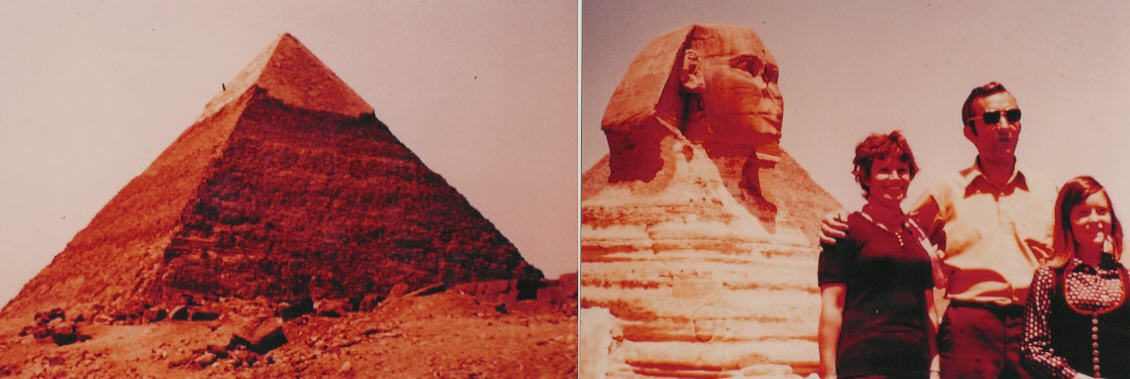
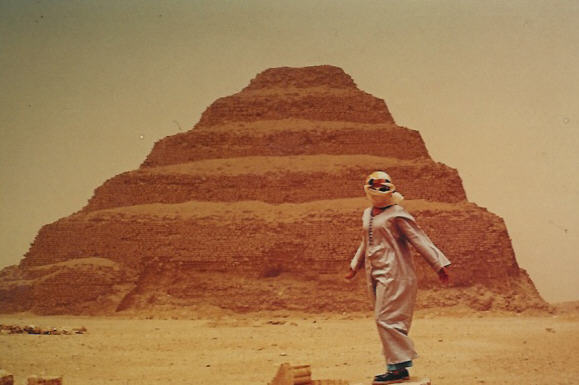
Egypt (1972)
The Land of the Pharaohs
I
n April of 1972, Valerie, Jill and I traveled to Egypt with the Ferrania Touring Club . . . all-in-all two hundred ninety three Italians and seven Americans.Cairo. It’s a longer trip from Genoa down to Cairo than you might think . . .. . . almost four hours of flying time. A refueling stop is made at Athens, which is almost exactly the halfway point from Milan. We arrived in Cairo after sunset . . . and, although we craned our necks from the plane windows, we couldn’t pick out the pyramids at the outskirts of Cairo as the plane descended in the gathering dusk.
I guess the pyramids at Giza and the sphinx are the inevitable first stops on any Egyptian tour itinerary. We went out the first morning after our arrival. It was a surprise to find them so close to downtown Cairo . . . only about fifteen minutes from our hotel. In fact, you can see them from the hotel’s rooftop restaurant.
 |
 |
Giza Pyramid The Sphinx and His Friends Jill Braves Sand Storm at Sakhara Pyramid
The bus drops you off a few hundred yard from the foot of the pyramids and you ride on camels for the last leg. It’s obviously a bit touristy . . . but, nevertheless, a lot of fun. With a guide we were able to go inside a pyramid directly into the burial chamber following a maze of four foot high corridors, which run up and down at 30 degree inclines.
The tour continued into the Moslem sector of the city with its four hundred mosques and famous citadel built by Saladdin in defense against the crusaders in the Middle Ages and finished at the Cairo museum with its unequaled collection of ancient Egyptian treasures. We were prepared for the disappointment of finding the Tutankhamen exhibit away on temporary display in the British Museum but it was still a blow to find the glass case which normally houses the fifty million dollar funerary mask empty. Even so, enough was left behind of the treasures of Kin Tub’s tomb to get an idea of what a truly remarkable discovery it was to have found his tomb intact and untouched by grave robbers after 3500 years.
Luxor Early the next morning we flew down to Luxor, about four hundred miles south from Cairo. The flight was on Egypt Air, the Egyptian nation airlines, in a Russian built turboprop. On this flight we gained our first real impression of the vastness of the desert which extends on either side of the Nile river valley and with it the comprehension that Egypt, although a large country on the map, is really only a very narrow ribbon of green, habitable land which extend for a few miles on either side of the Nile River. One understands why Egypt is called the "Gift of the Nile". Without the life-giving river, it would be only a vast and desolate desert.
Our hotel in Luxor was overlooking the Nile and our first excursion was a ride up the river a few miles on a felucca . . the traditional Nile sailing boat with the distinctive sail configuration which silhouettes so nicely for the postcard photos of the Nile sunset. Our hotel with its swimming pool was an oasis of cool and comfort surrounded by the dusty little town of Luxor and the forbidding desert beyond . With the temperatures rising about 100 degrees at midday, we lived by the swimming pool before and after our excursions.
Luxor was once called Thebes and was the capital of ancient Egypt and home to the pharaohs and over three million people. It was here that the pharaohs built the Temples of Luxor and Karnak, the latter considered as one of the seven wonders of the ancient world. Across the river and into the low mountains beyond was the City of the Dead where the pharaohs of the New Kingdom are entombed. The Valley of the Kings, as it is now called, is an underground necropolis of narrow tunnels and precipitous stairways leading down into the burial chambers.
The pyramidal tombs of the Old Kingdom, they had realized, were too conspicuous, so they tunneled underground in the wild, remote canyon to avoid grave robbers. . . to little avail though, since of the sixty or so pharaohs buried there, only Tutankhamen’s tomb escaped the plunderers. There may be another three tombs still unopened . . since two or three pharaohs aren’t clearly accounted for .. . but the archeologists aren’t sure.
We went down into four tombs including King Tut’s The walls are covered with paintings and hieroglyphics. The color and degree of preservation in many rooms are such that it seems they were completed just the day before. To even start to understand the myriad of illustrations, pictures, symbols , objects, places and events pictured in the tombs requires a good guide (which we had) and a lot of time (which, unfortunately, we didn’t have).
 |
Jill Learns the Mysteries of the Pharaohs
On the way back from the Valley of the Kings we stopped at the Temple of Queen Hatshepsut. She was the only female pharaoh, wore a false beard and referred to herself with masculine pronouns. The temperatures reached 110 degrees that afternoon and despite the excitement of the these discoveries it was nice to get back to the swimming pool.
Aswan The next day we flew down to Aswan, which is 150 miles south of Luxor and only about that far again from Egypt’s border with Sudan. The principal attraction is the Soviet Union sponsored High Dam . . . the largest earth-filled dam in the world. The Russian presence is evident. We passed the housing complexes where the five thousand Russian technicians lived with their families during the construction of the dam. Many of the road signs are in both Arabic and Russian. We rubbed shoulders there with several Russian tour groups with their ruddy faces and cardboard suitcases.
The dam is impressive . . . three miles long and 300 feet above the Nile River bed. The backwater, called Lake Nasser, is still filling up. It will be full in 1975 and will create a lake extending over three hundred miles upriver. It is clearly a big step ahead for Egypt in terms of both flood control and electrical power generation. The negative aspect is that the 60,000 Nubian villagers, who would have been inundated by the new lake, had to be relocated to new homes away from the river banks which they have inhabited for thousands of years. Also displaced were many priceless treasures of the ancient Egyptian culture. Although the Temple at Abu Simbel was relocated down river at the last moment by a consortium of Western contributors, many similar reliquaries will slowly disappear under the rising waters of the new lake.
We took the evening train running along the Nile River back to Luxor from Aswan . What the train ride lacked in comfort was compensated for by the sights we saw from the train as it passed through the primitive villages and countryside well off the normal tourist routes.
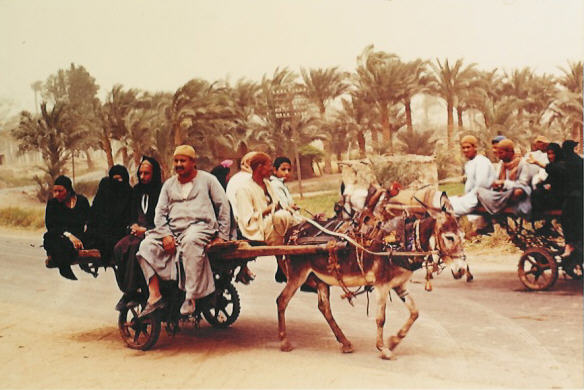 |
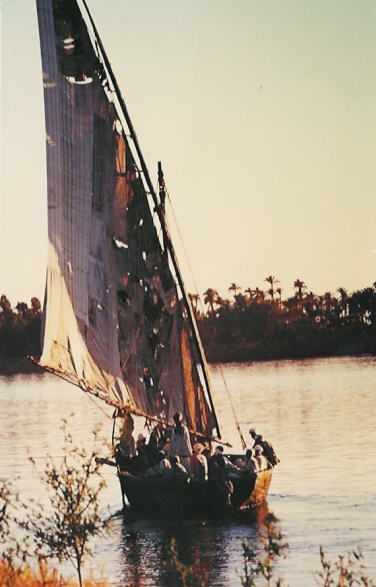 |
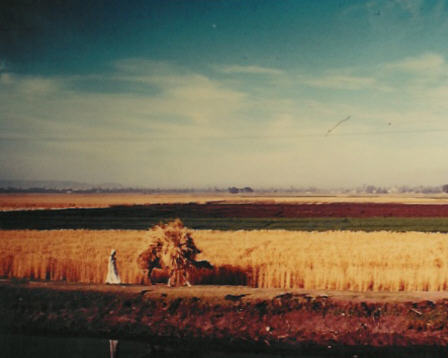 |
Scenes Along the Nile Felucca Farmer and his Camel
]